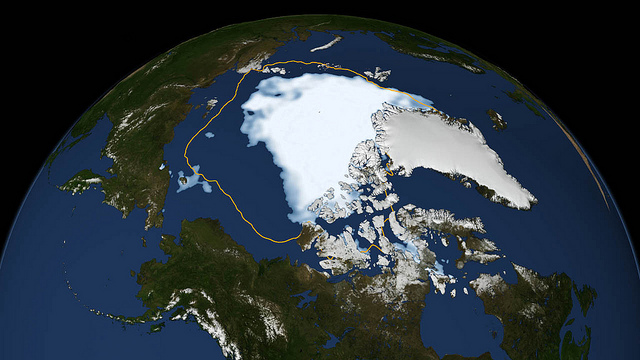Podcast: Play in new window | Download
Subscribe: RSS

The outline shows the normal extent of Arctic sea ice. This is where it was in the summer of 2012. But wait there’s more. (NASA Goddard photo)
A cascade of recent studies concludes that warming Arctic permafrost and ocean floors are on the verge of emitting massive methane eruptions that will quickly load the atmosphere with many times more greenhouse gas than has been produced during the entire Industrial Age. The ensuing warming will so destabilize the climate that a mass extinction may follow that could be the worst in 300 million years — since the so-called “Great Dying” of the Permian Period wiped out 90 per cent of sea life and 70 per cent of land animals. (Please insert the latest “how-could-there-be-global-warming-when-it’s- so-cold?” joke here.)
The methane eruptions have already begun. NASA scientists working in the Arctic last year, in the words of principal investigator Charles Miller, found “large, regional-scale episodic bursts of higher-than-normal carbon dioxide and methane in interior Alaska and across the North Slope during the spring thaw, and they lasted until after the fall refreeze. To cite another example, in July 2012 we saw methane levels over swamps in the Innoko Wilderness that were 650 parts per billion higher than normal background levels. That’s similar to what you might find in a large city.”
Permafrost covers one quarter of the land in the Northern Hemisphere. Its surface melts every summer, to a depth of a few inches to a few feet, depending on where it is. But the plants that manage to grow in this thin, wet surface never decompose. They die, are frozen, and the next year are quickly submerged by new growth into the great refrigerator of the North, where their carbon stays locked up and out of circulation. It has been working this way — accumulating — for hundreds of millennia.
Warm those dead plants, as climate change has begun to do, and they rot, releasing methane and carbon dioxide. How much? Well, the carbon footprint of the permafrost is estimated to be 1.5 trillion metric tons of carbon. Or five times the carbon emitted by human activities since 1850. And methane, which is the compound of carbon locked into the permafrost, is 100 times more potent than carbon dioxide as a greenhouse gas over a 20-year period. It’s a feedback loop, in which a little climate change induces a lot of climate change.
And that’s just the surface soil. An equivalent amount is locked into the floors of the Arctic Ocean and other northern seas. Whether, when and how fast these methane hydrates might be released by warming is not settled science (insert here latest conspiracy theory about lavishly paid, globe-trotting climate scientists). But researchers report that in the wake of rapidly retreating ice cover, areas of ocean surface as far as the eye can see are bubbling like champagne with escaping methane. And a recent study published in the journal Nature called the underwater stores “an economic time bomb.”
And British scientist John Nissen, chairman of the Arctic Methane Emergency Group, suggests that if the summer sea ice loss passes “the point of no return,” and “catastrophic Arctic methane feedbacks” kick in, we’ll be in an “instant planetary emergency.” That point of no return for Arctic Sea ice has in all probability already been passed. US Navy researchers expect the Arctic to be free of ice and warming rapidly in two years.
While the leaders of the world swing hysterically from branch to branch, hooting about a cold day in winter refuting all of climate science, on every front the planetary emergencies accumulate and accelerate. Anyone who has not acquired a sanctuary and begun to hone the skills of self-sustainable living, does not understand the situation.
Thanks, your article sums up the situation very well. Although not a hundred percent certain that the release is really picking up steam, all the early signs are there. By the way, the winter ice cover in the Arctic fell back to the level seen in the winter after the record low of 2012. Have a nice day you all.
Arctic ice recovered a bit in 2013, but it is far from normal. According to the National Snow and Ice Data Center, “While the most notable aspect of 2013 was the much higher September ice extent relative to the record low for 2012, extent in 2013 was nevertheless low overall. The maximum extent for 2013 of 15.13 million square kilometers (5.84 million square miles), recorded on 15 March was the sixth lowest over the period of satellite observations. The minimum of 5.10 million square kilometers (1.97 million square miles), recorded on 15 September, was also the sixth lowest. Continuing a recent pattern, ice extent remained below average over the northern North Atlantic throughout the year.”
Unfortunately, the primary response from governments of high-emission northern nations like Canada and Russia has been to ramp up Arctic exploration for more fossil fuels, to build more military bases to assert false sovereignty over the North Pole, and to hand out huge quota licenses to new fishing opportunities. Nothing quite like pouring an accelerant on a fire, is there?
It’s much worse:
http://arctic-news.blogspot.com/2014/01/high-methane-levels-over-the-arctic-ocean-on-january-14-2014.html